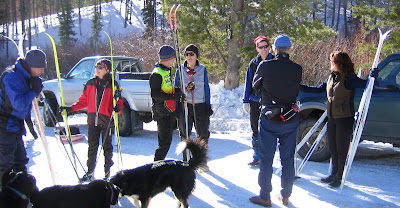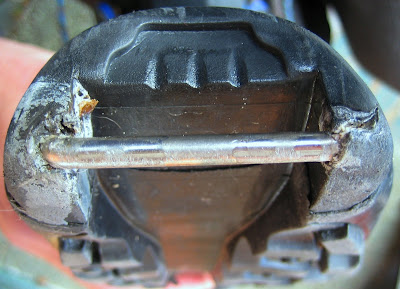No surprise: the Big Hole River Conservation Standards Review Board voted 6 to 2 for approval of KL Spear and Jane Spear's request for a variance to construct two bridges over public water for a private development near LaMarche Creek on the Big Hole River.
When I sat down next to Noorjahan Parwana, Director of the
Big Hole Watershed Committee, we agreed that the outcome was a foregone conclusion. In fact, the Review Board looked like a subcommittee of the Watershed Committee, dominated by Big Hole ranchers Liz Jones, Harold Peterson, Phil Ralston, and Ray Weaver. It's not that they are bad folks, they are just drop-dead conservative when it comes to the issue of private property rights.
Here's the board (L-to-R: Tilman, Ralston, unknown, Weaver, unknown, Markovich, Peterson, Jones):

The board was created to make recommendations regarding developments within 150-feet of the highwater mark of the Big Hole River. Because the river flows through four counties, all four governments are represented on the board.
Bob Horne, a planning consultant for Anaconda-Deer Lodge County, began with a cogent presentation to the board about the county's reasons for denying the bridge permit per county ordinance 208 (see links, below).
Bill Anderson, a development consultant representing the Spears, attacked the Anaconda-Deer Lodge County ordinance because it does not specifically define "structure" as the similar ordinance in Beaverhead County defines it--i.e. as a "building with a roof." Thus, he argued, a bridge should not be considered a structure. How ridiculous is that? Furthermore, although Anderson repeatedly stated that permitting the Spear bridges would not set a precedent for future bridges, he also repeatedly referred to the Ellingson/Meriwether "ranch" bridges (which he engineered) as a precedent!
As orderly public meetings go, it was a free-for-all. Harold Peterson was chair, but never controlled the agenda.
Wally Congdon, a Beaverhead County rancher, lawyer, and private property rights advocate, rambled on for about an hour regarding an old river ford that is part of the Spear ranch property. Wally tried to convince everyone that permitting the bridges in exchange for a conveyance of the right-to-ford was a good deal for the public--never mind that the new owners want to drive fancy SUVs to trophy homes across a bridge and not through the river, and that the ford has never been used in at least 20 years. Despite rumbling from the audience, Wally was allowed to go on. And on. And on.
Well, Wally's filibustering effectively cut down on how much public comment could be received. Too bad: of the approximately 40 people in the audience, only Wally spoke in favor of the bridges. While an audience of 40 does not seem like many, given the local population, this would be like 10,000 people turning out for a public hearing in New York City. Some of the crowd at the Wise River meeting:

Groups speaking out against the bridges included the
Public Land/Water Access Association, Inc., Skyline Sporstmens Club (Butte), Anaconda Sportsmens Club, and George Grant chapter of Trout Unlimited.
Here's
Tom Bugni (standing, red cap), speaking on behalf of Skyline Sportsmen (Tom was one of the heroes that led the
Montana Stream Access battle many years ago):

I felt
George Grant roll over in his grave, as the organization he established to protect the river -- the
Big Hole River Foundation -- took no position. As the lawyers say, "Silence implies consent." Seems the Watershed Committee has become so strong and successful, that its position intimidates member-groups such as the foundation from acting in ways that Watershed Committee members oppose.
As public comment was quickly brought to a close, review board member
Bill Markovich made an impassioned argument
against the bridges. Bill argued that the "The 150-foot setback in the county's ordinance is of critical importance to the natural values that make the Big Hole River special... The very existence of the bridge structure within the river corridor violates the letter and spirit of the ordinance... Even as a real estate developer, I recognize that the privilege of one private property owner does not outweigh the public good..." Wow. Here is a man able to transcend his own material self-interest to recognize a greater public good. How rare is that in today's world?
Following public comment and some discussion among the board,
Ray Tilman made a motioni to accept ADLC's denial of the variance, Bill Markovich seconded, and all other members voted against the motion.
Two next steps:
1. Montana's Department of Natural Resources & Conservation is accepting public comment on the
Spear Bridge Environmental Assessment until 30 January 2009. Comments may be sent to Tim Egan with the DNRC at 730 N. Montanan St. Dillon, MT 59725 or to his email at
tegan@mt.gov.
2. The Anaconda-Deer Lodge County Council of Commissioners will make a decision on the variance. Stay posted for more news.
Additional sources:
ADLC documents on the Spear bridges proposal, including Planning Department reports, request for variance (prepared by Anderson), a DNRC review of Anderson's hydrology report, letters from Montana Fish, Wildlife & Parks opposing the bridges, and ADLC Ordinance 208.
Thanks to Connie Daniels, ADLC Planner, and Paula Arneson, ADLC Planning Department staff member for supplying me with relevant documents and information.




















































